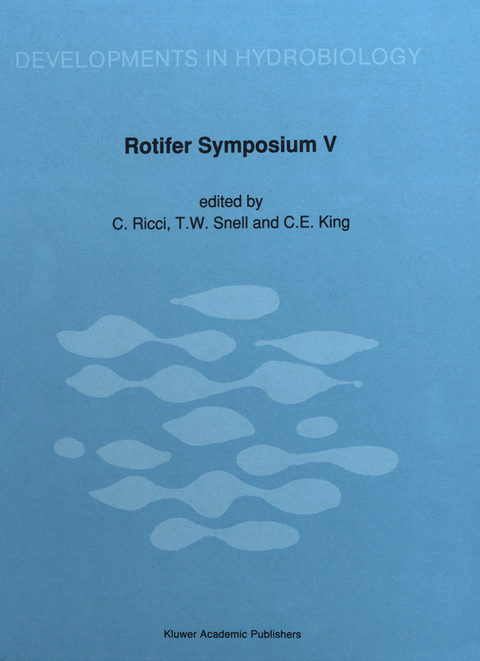
Rotifer Symposium V
Springer (Verlag)
978-94-010-6694-5 (ISBN)
Rotifer study as a way of life.- Rotifer study as a way of life.- One: Ecology.- Food.- Food limitation and body size in the life cycles of planktonic rotifers and cladocerans.- Is food availability the main factor controlling the abundance of Euchlanis dilatata lucksiana Hauer in a shallow, hypertrophic lake?.- Influence of cyanobacterial diet on Asplanchna predation risk in Brachionus calyciflorus.- Nutritional effect of freshwater Chlorella on growth of the rotifer Brachionus plicatilis.- Life history characteristics of Brachionus plicatilis (rotifera) fed different algae.- Feeding kinetics of Brachionus plicatilis fed Isochrysis galbana.- Competition.- Epizoic and parasitic rotifers.- Interrelations of rotifers with predatory and herbivorous Cladocera: a review of Russian works.- Competitive interactions between the rotifer Synchaeta oblonga and the cladoceran Scapholeberis kingi Sars.- Autoecology.- Salinity and temperature influence in rotifer life history characteristics.- Empirical evidence for a complex diurnal movement in Hexarthra bulgarica from an oligotrophic high mountain lake (La Caldera, Spain).- Morphological variation in Kellicottia longispina.- Morphological structure and functional patterns of Keratella cochlearis (Gosse) populations in stratified lakes.- The development of Hexarthra spp. in a shallow alkaline lake.- On choice of substrate and habitat in brachionid rotifers.- Temporal analysis of clonal structure in a moss bdelloid population.- Horizontal distribution of the plankton rotifers Keratella cochlearis (Bory de St Vincent) and Polyarthra vulgaris (Carlin) in a small eutrophic lake.- Oviposition behavior of the littoral rotifer Euchlanis dilatata.- Developmental times of Synchaeta oblonga eggs from the Danube (Austria).- Communities.- Community structure and coexistence of the rotifers of an artificial crater lake.- The rotifer communities of acid-stressed lakes of Maine.- Composition and distributional patterns in arctic rotifers.- Abundance and diversity of planktonic rotifers in the Po River.- Rotifer distribution in relation to temperature and oxygen content.- Patterns in the composition of the rotifer communities from high mountain lakes and ponds in Sierra Nevada (Spain).- Rotifer associations of some wetlands in Ontario, Canada.- Opportunist rotifers: colonising species of young ponds in Surrey, England.- Percentage of rotifers in spring zooplankton in lakes of different trophy.- Tasmania revisited: rotifer communities and habitat heterogeneity.- Occurrence of Rotifera in the field under natural and intentionally-changed conditions. II. Lake Numasawa.- Two: Taxonomy and Morphology.- The skeletal muscles of rotifers and their innervations.- Classical taxonomy and modern methodology.- Mastax morphology under SEM and its usefulness in reconstructing rotifer phylogeny and systematic.- Problems in taxonomy of rotifers, exemplified by the Filinia longiseta-terminalis complex.- Systematics, reproductive isolation and species boundaries in monogonont rotifers.- Phylogenetic relationships within phylum Rotifera: orders and genus Notholca.- A re-appraisal of two members of the genus Notholca from the Andes, with a note on the fine structure of the lorica of N. foliacea (Ehrenberg).- Three: Physiology.- Protein patterns in rotifers: the timing of aging.- Brachionus plicatilis tolerance to low oxygen concentrations.- Analysis of protein, carbohydrate and lipid in rotifers.- A laboratory study of phosphorus and nitrogen excretion of Euchlanis dilatata lucksiana.- A new method to estimate individual dry weightsof rotifers.- Temperature aspects of ecological bioenergetics in Brachionus angularis (Rotatoria).- Biomass and elemental composition (C.H.N.) of the rotifer Brachionus plicatilis cultured as larval food.- Four: Genetics.- Molecular genetics of rotifers: preliminary restriction mapping of the mitochondrial genome of Brachionus plicatilis.- Size variation in Brachionus plicatilis resting eggs.- Five: Aquaculture.- Rotifers as food in aquaculture.- Nitrogen flow through a Brachionus/Chlorella mass culture system.- Kinetics of n-3 fatty acids in Brachionus plicatilis and changes in the food supply.- Effect of incubation and preservation on resting egg hatching and mixis in the derived clones of the rotifer Brachionus plicatilis.- Intensive rotifer cultures using chemostats.- Author Index.
| Reihe/Serie | Developments in Hydrobiology ; 52 |
|---|---|
| Zusatzinfo | 464 p. |
| Verlagsort | Dordrecht |
| Sprache | englisch |
| Maße | 210 x 280 mm |
| Themenwelt | Sachbuch/Ratgeber ► Natur / Technik ► Naturführer |
| Naturwissenschaften ► Biologie ► Limnologie / Meeresbiologie | |
| Naturwissenschaften ► Biologie ► Ökologie / Naturschutz | |
| Naturwissenschaften ► Biologie ► Zoologie | |
| ISBN-10 | 94-010-6694-9 / 9401066949 |
| ISBN-13 | 978-94-010-6694-5 / 9789401066945 |
| Zustand | Neuware |
| Haben Sie eine Frage zum Produkt? |
aus dem Bereich


